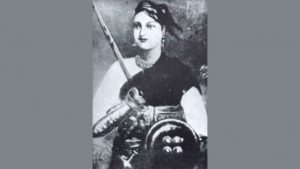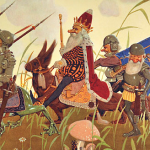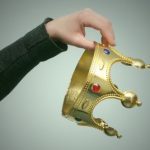 Weird Stuff
Weird Stuff  Weird Stuff
Weird Stuff  Our World
Our World 10 Ways Your Christmas Tree Is More Lit Than You Think
 Movies and TV
Movies and TV The 10 Coolest Stars to Set Sail on The Love Boat
 History
History 10 Things You Didn’t Know About the American National Anthem
 Technology
Technology Top 10 Everyday Tech Buzzwords That Hide a Darker Past
 Humans
Humans 10 Everyday Human Behaviors That Are Actually Survival Instincts
 Animals
Animals 10 Animals That Humiliated and Harmed Historical Leaders
 History
History 10 Most Influential Protests in Modern History
 Creepy
Creepy 10 More Representations of Death from Myth, Legend, and Folktale
 Technology
Technology 10 Scientific Breakthroughs of 2025 That’ll Change Everything
 Weird Stuff
Weird Stuff Ten Bizarre Facts About The Doge Meme
 Our World
Our World 10 Ways Your Christmas Tree Is More Lit Than You Think
 Movies and TV
Movies and TV The 10 Coolest Stars to Set Sail on The Love Boat
Who's Behind Listverse?

Jamie Frater
Head Editor
Jamie founded Listverse due to an insatiable desire to share fascinating, obscure, and bizarre facts. He has been a guest speaker on numerous national radio and television stations and is a five time published author.
More About Us History
History 10 Things You Didn’t Know About the American National Anthem
 Technology
Technology Top 10 Everyday Tech Buzzwords That Hide a Darker Past
 Humans
Humans 10 Everyday Human Behaviors That Are Actually Survival Instincts
 Animals
Animals 10 Animals That Humiliated and Harmed Historical Leaders
 History
History 10 Most Influential Protests in Modern History
 Creepy
Creepy 10 More Representations of Death from Myth, Legend, and Folktale
 Technology
Technology 10 Scientific Breakthroughs of 2025 That’ll Change Everything
10 Brave Royals Killed in Battle
You might think that the lives of royals are highly enviable, what with all the palaces and the gilded lifestyles that we commoners can only dream of. But being of royal blood can have some severe drawbacks. Because if you’re the master, or mistress, of all you survey, there’s a very good chance that someone else wants what’s yours. So you may well be forced to fight to hang on to your realm, and battlefields carry a notoriously high risk of serious injury or death. Here, we tell the sad tales of ten royals who died fighting.
Related: Top 10 Poorly Planned Battles
10 Rani Lakshmi Bai

Born in 1835, Lakshmi Bai was Rani, or the queen in India, of the Jhansi city-state in northern India. She had what, for a high-caste Hindu girl, was a highly unusual upbringing at the court of the Jhansi ruler Baji Rao II. Lakshmi Bai was educated with boys, and the curriculum included horse riding, martial arts, and sword fighting. She wed Jhansi Maharajah Gangadhar Rao, and when he died, she took the reins of power.
The Rani was just 22 when the British decided to annex Jhansi, a proposition that she entirely rejected. When the Indian Mutiny against British colonial rule erupted in 1857, she took the opportunity to join the violent rebellion and became a regional leader of the uprising. When the fortifications of Jhansi were overwhelmed by the British, Lakshmi Bai escaped with a handful of followers who went on to seize another city, Gwalior. She then joined battle with a British force led by General Hugh Rose, and while fighting alongside her troops while dressed as a man, the Rani was killed.[1]
9 Richard I of England
Richard I of England, best remembered as Richard the Lionheart, came to the English throne aged 32 in 1189 and ruled for a decade. Extraordinarily, he spent just six months of his reign in England, spending the rest of his time crusading in the Middle East or fighting against European enemies. Richard returned to England in 1194 but soon left for France. In fact, the king would never see England again.
In 1199, Richard laid siege to Châlus-Chabrol Castle in France, where there was said to be a hoard of gold that Richard believed should be his. During the siege, Richard was hit in the shoulder by a crossbow bolt fired from the castle by one Pierre Basile. Gangrene infected the wound, and the king was soon dead. Before he died, he’d told his entourage that Basile should be rewarded for his skill. But the king’s lieutenant, one Mercadier, instead had the unfortunate Frenchman skinned alive and hanged.[2]
8 James II of Scotland
At age six, James II inherited the Scottish throne upon the murder of his father, James I, in 1430. Three leading families feuded for control of the young king until 1449 when James took independent charge of his country. He showed himself to be a man with a capacity for decisive action in 1452 when he stabbed his rival William, 8th Earl of Douglas, to death. He followed that up by seizing the Douglas lands and destroying their castles.
Having made his definitive mark on Scottish politics, like so many Scottish monarchs before and after him, James now sought battle with the English. His southern enemies had an outpost in the Scottish borderlands centered on the formidable bulk of Roxburgh Castle. In 1460, James laid siege to the castle using the not-always-failsafe artillery of the day. Sure enough, one cannon exploded, severely wounding the 29-year-old king, who died soon after.[3]
7 Richard III of England
Richard III was a distant descendant of Richard I, whose crossbow woes we heard about earlier, but the third Richard ruled England nearly 300 years after his ancestor and namesake had. Richard III was crowned in 1483 at a time when his realm was convulsed by the civil conflict known as the Wars of the Roses. The war was basically about who should rule England, so Richard was closely involved in the fighting.
The final round of the Wars of the Roses, the Battle of Bosworth Field, was fought in the English Midlands near the city of Leicester in 1785 when Richard’s supporters faced off against those who backed Henry Tudor. The action went badly for Richard who eventually found himself surrounded by enemy troops with no way to escape. In his play titled Richard III, Shakespeare gave the king the immortal line, “A horse, a horse, my kingdom for a horse!” No horse was forthcoming, and the back of Richard’s skull was smashed off with a halberd. His nemesis became King Henry VII.[4]
6 King Charles XII of Sweden
Charles XII, described by the Smithsonian Magazine as “austere and fanatical, intelligent yet foolhardy,” sat on the Swedish throne from 1697. He spent much of his reign fighting in the Great Northern War, which lasted for 21 years starting in 1700. Charles was despised by many Swedes because war was (and is) expensive, and much of his country was afflicted by dire poverty. The playwright August Strindberg claimed that Charles was “Sweden’s ruin, the great offender, a ruffian, the rowdies’ idol.”
Charles enjoyed several battlefield victories over the years, defeating enemies such as the Poles, the Saxons, and the Russians. A turning point came when he invaded Russia in 1708 and was decisively routed at the Battle of Poltava. But that did not put an end to the king’s appetite for war, and in 1718, he attacked his Danish neighbors. While overseeing trench building within range of the Danes, 36-year-old Charles took a bullet or piece of grapeshot to the head and was killed instantly. Some said he was the victim of deliberate friendly fire, and controversy about his death continues to this day.[5]
5 James III of Scotland
We covered the death of James II at Roxburgh Castle earlier but didn’t include the detail that on the day he died, his son was crowned in the conveniently nearby Kelso Abbey. Like his father before him, James III was just a child when he came to the throne in 1460, aged nine. Early in his reign, his mother, Mary de Gueldres, acted as regent of Scotland, but after her death in 1463, rival Scottish noble families fought for control of the young king in a repeat of his father’s plight.
James took real power over his nation in 1468 but was opposed by rebellious nobles, including his own brothers Alexander and John. John died in Edinburgh under murky circumstances, and Alexander was charged with treason and exiled. But in 1482, Alexander returned as the head of a rebel army that narrowly failed to take control of Scotland. Yet another rebellion erupted in 1488, this time led by James’s own son, also called James. Things came to a head at the pitched Battle of Sauchieburn, fought near Stirling. The king’s forces were routed, and James was killed during the battle.[6]
4 King Harold II of England
Harold II of England was crowned on the death of his father, Edward the Confessor, in January 1066. Harold was soon faced with a national crisis when an army led by an alliance between Tostig, Earl of Northumbria, in northern England, and Harald Hardrada, King of Norway, threatened the king’s throne. Harold marched north to the city of York as the head of his army and won the Battle of Stamford Bridge, where both Harald Hardrada and Tostig were killed.
But just three days later, the Norman William the Conqueror landed on the south coast of England to stake his claim to the crown. This was awkward for Harold since he was many miles away in the north of England with his army. But he rushed south and confronted William at the 1066 Battle of Hastings. Harold’s men were roundly defeated, and the king himself was killed, likely hit in the eye by an arrow. William now took the English throne.[7]
3 King James IV of Scotland
As we’ve seen, Scottish kings called James had a habit of being killed in battle, and James IV was no exception. This James became king when, as we’ve seen, his father, James III, died at the Battle of Sauchieburn in 1488. Although he was just 15 when he succeeded to the crown, the energetic James quickly began to exercise his royal authority.
Scotland was much more peaceful than it had been under the rule of his father and his grandfather, but there was nevertheless a fly in the ointment: England. James’s forces made various incursions across the border, but it wasn’t until James made a determined raid into England in 1513, capturing four castles, that things got really serious. Henry VIII of England decided it was time to deal with his troublesome northern neighbor, and an English army faced up to James’s forces at the Battle of Flodden in northern England. The English emerged victorious after a bloody clash in which James was killed by a lethal blow from a billhook. Some 10,000 of his countrymen also died, including most of Scotland’s nobles.[8]
2 Princess Gwenllian
Born in 1100, Gwenllian was a Welsh warrior princess who was descended from the last High King of Ireland, Brian Boru. In her teens, Gwenllian married Prince Gruffydd ap Rhys and so became Princess Consort of Deheubarth, a kingdom that encompassed the south of Wales. The land was under dire threat from the English, who had established military outposts there. Gwenllian and Gruffydd led raids on the invaders, actions which made them folk heroes among their Welsh compatriots, especially when they distributed plundered English booty to the populace.
In the meantime, England descended into chaos because of a civil war sparked by rivals for the English throne. The Welsh took their opportunity to attack the English, winning a victory at the Battle of Llwchwr over the Anglo-Norman Maurice de Londres, Lord of Kidwelly. But Kidwelly planned his revenge and began to roll back the Welsh. Gwenllian, now alone as her husband was fighting elsewhere, was determined to resist the English at the head of a guerilla army. But the English caught up with her small force in 1136, and in the ensuing battle, the princess was captured and beheaded on the spot.[9]
1 Malcolm III of Scotland
Here we have yet another medieval Scottish king who died in battle, although for once, he wasn’t called James. If a Scottish king named Malcolm rings a bell, you may well be thinking of Shakespeare’s Macbeth. In the play (spoiler alert), it’s Malcolm who kills Macbeth, and in real life, that is just what Malcolm did in 1057 to claim the crown of Scotland. Since Macbeth had killed his father, Duncan I, you can hardly blame him.
It won’t surprise you to learn that once on the throne, Malcolm’s problems centered on his fractious relationship with England. Malcolm decided it would be a good idea to raid northern England, which he did on a number of occasions until a peace treaty was signed in 1072. But Malcolm broke the agreement by continuing his forays into his neighbor’s land. After a 1093 raid on the Northumbrian town of Alnwick, Malcolm was ambushed while accompanied by only a handful of his knights and was killed in the ensuing skirmish.[10]








